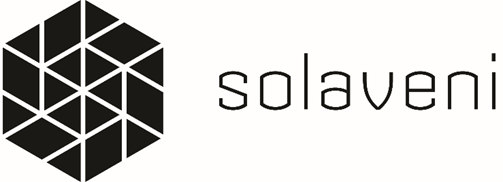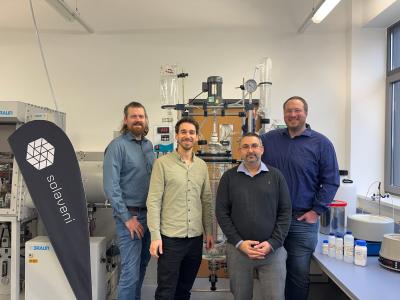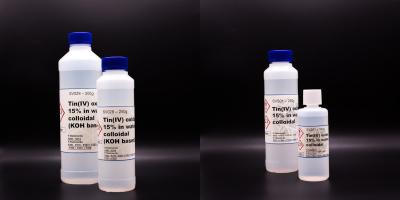When it comes to innovation in advanced materials, Solaveni GmbH stands out as a company with a bold mission. Founded in 2021 as a subsidiary of Saule Technologies, Solaveni was created with a vision to revolutionize the world of perovskite-based materials by focusing on sustainable chemistry and environmental responsibility. Today, the company is carving out a space in fields like printed electronics, energy harvesting, storage, and solid-state lighting, all while ensuring its processes remain green and future-ready.
At the heart of Solaveni’s journey is its CEO, Dr. Senol Öz, whose expertise and passion for perovskite technology have been key to the company’s progress. Senol’s career spans over a decade of research and hands-on experience in solution-processing and chemical engineering of perovskite solar cells. From his doctoral work in Germany, to his postdoctoral research in Japan, and eventually joining Saule Technologies, his path has been defined by a deep commitment to advancing perovskite materials.
We had the opportunity to sit down with Senol for an insightful Q&A, where he shared his thoughts on Solaveni’s vision, the challenges of perovskite technology, and the future of sustainable material production. Let’s dive into the conversation!
Solaveni was established in 2021 as a subsidiary of Saule Technologies, one of the pioneers in the perovskite solar industry. Why did Saule decide to establish a materials subsidiary?
Saule Technologies, a trailblazer in the perovskite solar industry, founded Solaveni in 2021 to address the burgeoning demand for high-quality, innovative materials critical to advancing solar technology. The establishment of Solaveni reflects Saule’s strategic vision to enhance and diversify its capabilities within the renewable energy sector. By creating a specialized subsidiary, Saule aims to streamline the development and production of materials relevant for the perovskite ecosystem, ensuring consistent quality and fostering innovation.
The decision to establish Solaveni also stems from Saule's commitment to driving the commercialization of perovskite solar cells. As a dedicated materials subsidiary, Solaveni can focus on optimizing the properties and manufacturing processes of perovskites, thereby accelerating the deployment of next-generation solar solutions. This move not only strengthens Saule’s position in the market but also contributes to the broader goal of making solar energy more efficient, accessible, and sustainable.
Furthermore, Solaveni enables Saule to better serve its partners and customers by providing tailored material solutions that meet specific needs. This customer-centric approach enhances collaboration and innovation across the industry, paving the way for new applications and technologies that leverage the unique advantages of perovskite materials.
Can you introduce us to your most successful materials? What does it take to succeed in the perovskite material business?
Solaveni has achieved notable success in the perovskite material business, largely due to the development of key materials such as aqueous SnO2 (tin (IV) oxide) nanoparticle dispersions, FAI (formamidinium iodide), MAI (methylammonium iodide), PbI2 (lead iodide), and PbBr2 (lead bromide). Our unique production process enables ultra-high purity perovskite precursors with a trace metal purity of up to >99.9999% (6N), combined with the lowest trace water content and supreme solubility. To the best of our knowledge, no other manufacturer currently offers these purity levels as powders. These materials form the cornerstone of our product offerings, driving advancements in perovskite solar technology and enabling high-performance, reproducible, and cost-effective solar cells. Our commitment to delivering the highest quality standards ensures that every material we produce meets stringent performance benchmarks, fostering long-term partnerships with leading solar manufacturers worldwide.
Additionally, we have achieved a remarkable 87% reduction in environmental impact across 13 distinct Life Cycle Assessment (LCA) impact categories for the synthesis of organic alkylammonium iodides such as MAI, reflecting our dedication to sustainability. The focus on quality, consistency, and environmental responsibility underscores Solaveni's role as a trusted partner in advancing cutting-edge photovoltaic innovations.
In the field of perovskite research, there are still many of new ideas about improving the composition of the perovskite material and the optimizing charge transport layers. Alongside closely following the market and supply levels, it is crucial for us to stay up to date with new developments and ideas in the field that are presented at conferences or published in literature. For this reason, we maintain close contact with our customers to identify their needs and develop promising products from the outset. In the meantime we have extended our product palette from the iodides and bromides of MA, FA, and Pb to the respective chlorides. Particularly in view of tackling the stability concerns of perovskite thin film technology, we anticipate that the availability and access to ultra high purity precursor materials might become a game changer, as we have witnessed in the past with other technologies such as OLEDs, where high purity materials enabled long-term operational stability.
We understand there are some new products in the pipeline. Can you tell us a bit about these new products?
At Solaveni, we are excited to announce several new products in the pipeline, particularly in response to the growing demand for water-based dispersions of SnO2 (tin (IV) oxide) and NiOx (nickel (II) oxide). These developments have been driven by supply chain challenges and supported through extensive collaboration with Saule Technologies, academic partners, and RTOs across Europe. Our efforts are further bolstered by Horizon Europe Projects, including PEARL, HEPAFLEX, SOLMATES, PERSEUS and APOLLO. We are eager to see what the scientific community will achieve with our novel line of 6N purity perovskite precursors.
Do you mostly engage in materials aimed towards R&D, or are you also aiming to supply industrial-scale materials?
As the commercialization and industrial production of perovskite solar cells rapidly approaches, with a major breakthrough on the horizon, we are proud to already be supplying our high-quality materials internationally to both academic institutions and RTOs. These organizations are actively engaged in fundamental and applied research, laying the groundwork for technological advancements.
Furthermore, many industrial players worldwide are already incorporating our materials into their processes, leveraging our expertise and product quality to enhance their development pipelines. As the demand for large-scale supply grows with the approaching commercial breakthrough, we are well-prepared to meet these evolving needs. Thanks to our highly scalable production processes and capacity, we stand ready to support the global perovskite module manufacturers of today and tomorrow.
How do you see Solaveni in the next 3-5 years? What role will you have in this industry?
Apart from our role as a supplier of materials, Solaveni aims to continue pioneering in the materials science and thin film photovoltaic industries with a primary focus on sustainability, performance, and innovation. We want to integrate green chemistry principles into the development of new materials as well as into the optimization and upscaling of synthesis processes. Looking further into the future: we are considering end of life solutions for perovskite solar modules. Will they become a new environmental burdon or can we establish a sustainable recycling process before this question becomes pressuring? To address this, Solaveni proudly takes part as a consortium member in Horizon Europe projects funded by the EU.
We understand Solaveni is engaged in some EU-funded R&D projects. Can you share some details on your work in these projects?
In HEPAFLEX, we focus on the synthesis and supply of materials, scaling up our production process. Additionally, we are exploring recovery and recycling processes for end-of-life modules up to 400 cm² in size.
The main activity in SOLMATES involves developing an innovative recycling process for perovskite half cells in perovskite/CIGS tandem solar cells on a lab scale. In this project, we are also able to develop and supply materials requested specifically by our partners.
In APOLLO, our objective is the recycling of end-of-life flexible single-junction perovskite modules with a size of 1 m². Our main goal is to recover perovskite materials from modules to reuse them in the synthesis of our precursors, which will finally be used in the manufacture of new perovskite modules. In PERSEUS, we aim to repurpose valuable materials recovered from end-of-life lead-acid batteries utilizing our green chemistry approach.

We are eager to see how the community will use our materials - feel free to get in touch with us!
This was a sponsored post by Solaveni GmbH

